Earlier this year, we received an invitation to tour Anheuser-Busch’s hop farm in the Hallertau region of Germany. We were somewhat shocked to be contacted by A-B, but after talking to a few friends, it was definitely something we wanted to do. It didn’t fit into our schedule when we were here in May, but it did fit nicely into this trip.
 On Monday morning, Willy Buholzer, the Director of European Hop Purchasing and General Manager of Busch Farm Hüll, came to pick us up at our hotel, which was a good thing because I think we would have gotten lost trying to find the farm.
On Monday morning, Willy Buholzer, the Director of European Hop Purchasing and General Manager of Busch Farm Hüll, came to pick us up at our hotel, which was a good thing because I think we would have gotten lost trying to find the farm.
A friendly, down to earth guy, Willy easily chatted with Chris during the drive. Feeling a bit woozy from the previous night’s visit to Oktoberfest, I sat quietly in the back. We passed many hop farms along the way, but almost all had already been harvested and the large telephone poles that hold the hops were bare, but for a few brown dried up stragglers.
We did see several farms with young plants that were not harvested. The small plants, however, were only a fraction of the size that mature plants can grow to and far less impressive. But that was our fault for not being able to fit the tour in earlier in the year.
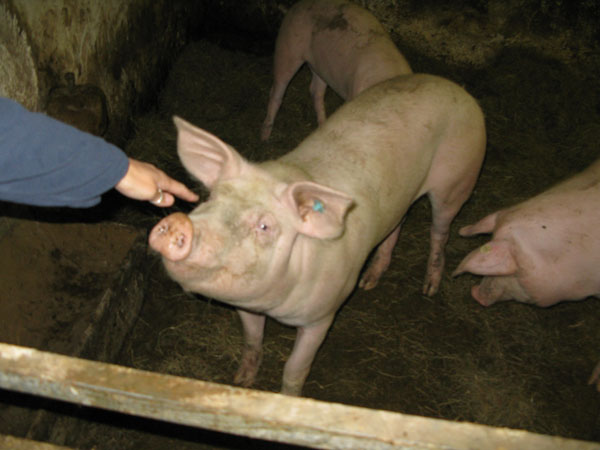 Willy started our tour by pointing out that Busch Farm Hüll is a real working farm, complete with pigs and chickens. After patting the muddy snouts of the pigs and interrupting the morning routine of the chickens, we moved on to the stuff we really came for, the hops.
Willy started our tour by pointing out that Busch Farm Hüll is a real working farm, complete with pigs and chickens. After patting the muddy snouts of the pigs and interrupting the morning routine of the chickens, we moved on to the stuff we really came for, the hops.
Everything was somewhat theoretical because their harvest was over, but we did get demonstrations of how the machinery worked. We saw everything from how the hop vines are harvested and stripped of the cones to how they are dried and baled. While the farm only produces a tiny portion of A-B’s hop needs, it is a vital presence in the world’s largest hop growing region.
Then we went across the street to the Hop Research Institute Hüll. The institute is a private/Bavarian state collaboration working independently to develop new varieties of hops that are heartier, more resistant to pests/diseases and with higher yields. The ‘breeder’, as he called himself, gave us the tour and we even got to meet the disease/bug expert who develops ways to combat things like downy mildew and spider mites.
At the institute, we learned everything we ever wanted to know about hops. We saw ‘seeded’ hops, which is not what you want for brewing, and learned about the two different petals on the hop cone. The pointy ones are to protect the cone and the rounded ones hold the seeds. Most importantly, we also were told that if a farmer finds a male plant, by law, he is to kill it immediately in order to avoid the other plants getting seeded.
Back at the farm, we sampled some beers before heading off to an actively harvesting farm and then lunch. We sampled Budweiser brewed with only Hallertau hops, one with only Willamette hops, one with no hops, and finally regular Budweiser. Chris especially liked the Hallertau Bud.
The tour of the still harvesting farm was very cool. We stepped out of the car and it seemed to be snowing hops.
 This particular farm was still harvesting for two reasons… first of all, it was the biggest in the region but also, on that day, they were harvesting high alpha hops that take longer to mature.
This particular farm was still harvesting for two reasons… first of all, it was the biggest in the region but also, on that day, they were harvesting high alpha hops that take longer to mature.
Here’s the harvesting process in a nutshell. A tractor with a trailer and a special cutting mechanism cuts the vines at the bottom and the vines roll onto the flatbed. The vines then get dropped off at the barn, where people hook the thick stems to a machine that pulls them up. The vines are then pulled into a machine that separates the leaves and stems from the cones. The cones travel to the kiln where they get dried. Once dried, the cones rest to cool off before they are baled. This process all happens within the space of hours.
To see a working hop farm in action was special and the smell was absolutely amazing.
Our time with Willy ended with lunch in the nearby town of Wolznach, also the home of a very impressive-looking Hop Museum. Unfortunately, it was closed.
How can I sum up our day?
Earlier at the farm, Willy had shown us a rough cut of a Michelob commercial that was filmed recently at Busch Farm Hüll. In this commercial, Willy is featured talking about buying hops for Anheuser Busch and what pride he takes in it. He is the face to a large corporation.
Normally I would find such commercials to be a big guy’s attempt to look small and intimate. But you know what? Willy really is a face of a large corporation. He is a man who was raised around hop farms, takes pride in showing off the farm, and loves everything hops. Willy even hinted that perhaps some day his 10 year old daughter will replace him, just as he had replaced his father as the hop buyer for Anheuser Busch. Willy is an extremely nice man and I couldn’t think of anyone better to spend several hours with talking about hops.

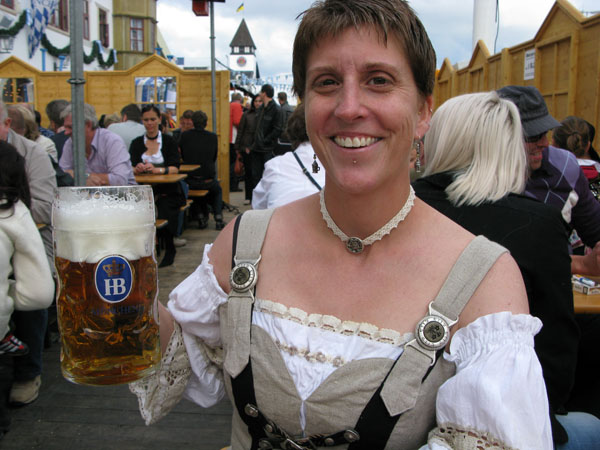 Sunday was the second day of Oktoberfest and we returned to the Theresienwiese under sunnier skies. Armed with a list of things we needed to shoot, we searched out the proper locations.
Sunday was the second day of Oktoberfest and we returned to the Theresienwiese under sunnier skies. Armed with a list of things we needed to shoot, we searched out the proper locations.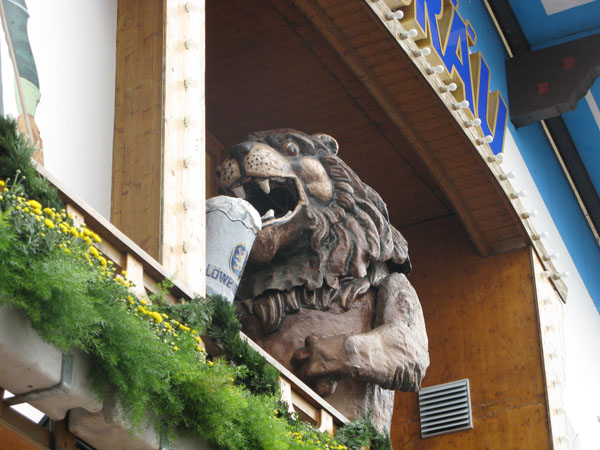 Moving on, we mistakenly went to the Lowenbrau Festhalle. I say mistakenly because we didn’t realize that the place was crawling with Aussies. I don’t mean to disparage a whole nation of people but twenty-something Aussies at Oktoberfest should be avoided. Drunken, loud and obnoxious, the main problem is that they travel in tour groups. So there are not just a few of them at your tent; there are hundreds.
Moving on, we mistakenly went to the Lowenbrau Festhalle. I say mistakenly because we didn’t realize that the place was crawling with Aussies. I don’t mean to disparage a whole nation of people but twenty-something Aussies at Oktoberfest should be avoided. Drunken, loud and obnoxious, the main problem is that they travel in tour groups. So there are not just a few of them at your tent; there are hundreds.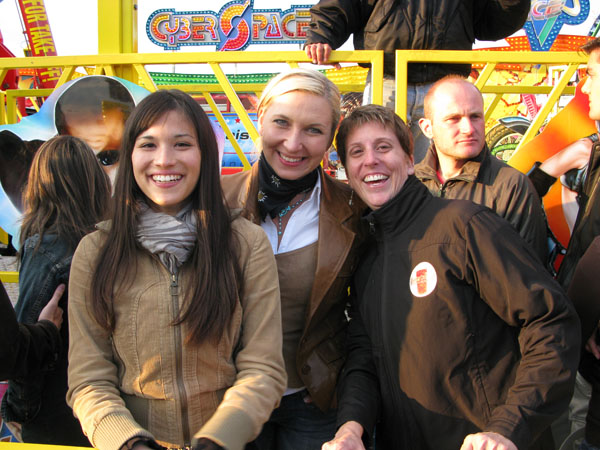 Merideth mentioned her desire to go on some of carnival rides and in our new friends she found two willing accomplices. The three of them ended up on two different puke-inducing rides.
Merideth mentioned her desire to go on some of carnival rides and in our new friends she found two willing accomplices. The three of them ended up on two different puke-inducing rides. Our day began with the Grand Entry of the Oktoberfest Landlords and Breweries… a parade. Each of the six Munich breweries plus the landlord of each tent is represented in the procession that begins in central Munich and ends up at the Theresienwiese, the site of Oktoberfest. There were also bands, a couple of clowns and plenty of horse poop. The only thing missing was the Shriners in their little cars. As the last few paraders were passing, we joined the masses streaming towards the festival grounds.
Our day began with the Grand Entry of the Oktoberfest Landlords and Breweries… a parade. Each of the six Munich breweries plus the landlord of each tent is represented in the procession that begins in central Munich and ends up at the Theresienwiese, the site of Oktoberfest. There were also bands, a couple of clowns and plenty of horse poop. The only thing missing was the Shriners in their little cars. As the last few paraders were passing, we joined the masses streaming towards the festival grounds.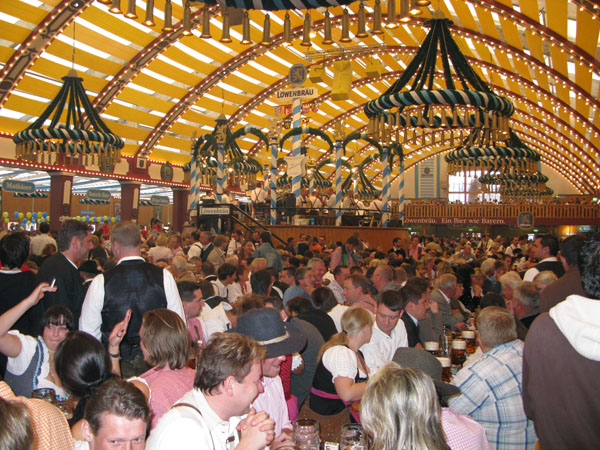 Next came the hard part, finding a seat. A seat is key, for without one you cannot get a beer. So, Merideth and I started trolling each tent outside and in (if we could get in) for a place to sit. This task on opening day can be somewhat time consuming and frustrating. You scan the sections of open spots and ask if you can sit there. Most of the time, the answer is no. And yesterday, adding to our frustration, was the fact that we had an agenda for filming; we needed footage.
Next came the hard part, finding a seat. A seat is key, for without one you cannot get a beer. So, Merideth and I started trolling each tent outside and in (if we could get in) for a place to sit. This task on opening day can be somewhat time consuming and frustrating. You scan the sections of open spots and ask if you can sit there. Most of the time, the answer is no. And yesterday, adding to our frustration, was the fact that we had an agenda for filming; we needed footage.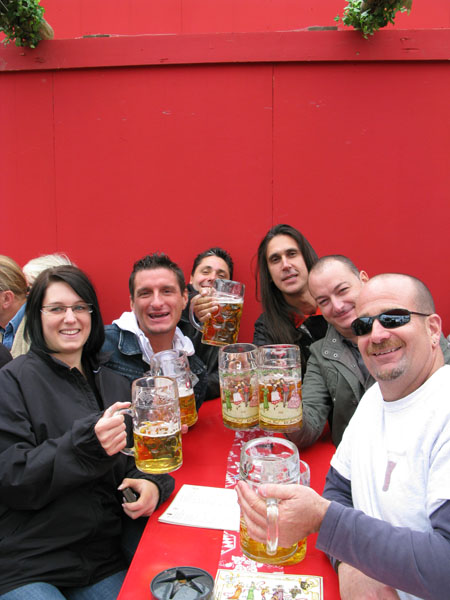 While on our quest, I actually got recognized. A German who I had talked to at the Bergkirchweih this past May saw me and came up to say ‘Hi’. Considering the number of people who were there yesterday, the fact that he saw and recognized me was amazing… unfortunately, he didn’t have a seat for us.
While on our quest, I actually got recognized. A German who I had talked to at the Bergkirchweih this past May saw me and came up to say ‘Hi’. Considering the number of people who were there yesterday, the fact that he saw and recognized me was amazing… unfortunately, he didn’t have a seat for us.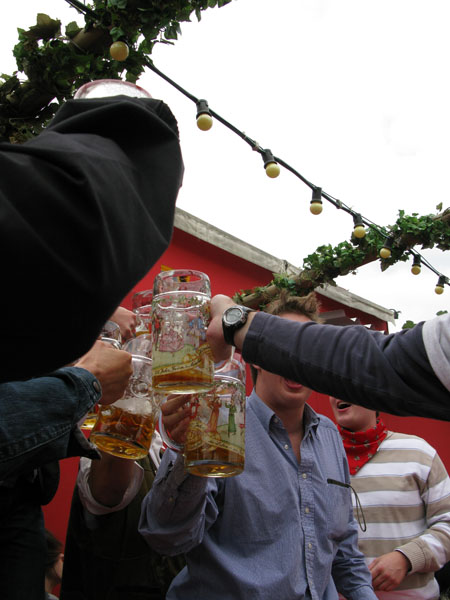 In fact, we were having so much fun that the manager came over and talked to the Italians and the Germans at the next table. Roughly translated, she said that the non-stop toasting behavior needed to wait another five hours to be appropriate. Those orderly Germans!
In fact, we were having so much fun that the manager came over and talked to the Italians and the Germans at the next table. Roughly translated, she said that the non-stop toasting behavior needed to wait another five hours to be appropriate. Those orderly Germans!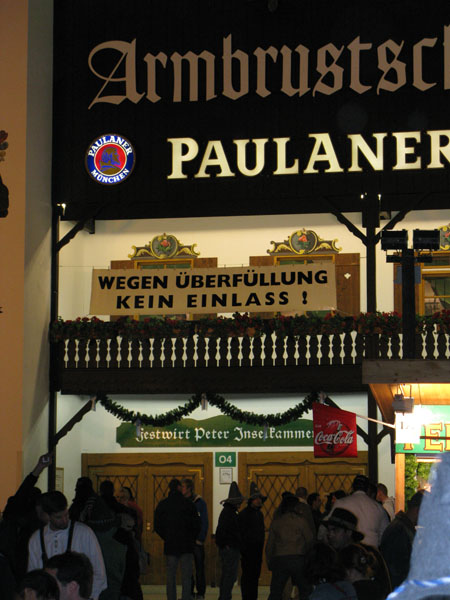 After three hours of fun and 4 liters between us, we called it a day. Though we will most likely never see them again, we had a great time with our Oktoberfest friends. I think it backs up what we say about Oktoberfest. It might be hard work… it might be frustrating… it is a test… but the payoff is worth it.
After three hours of fun and 4 liters between us, we called it a day. Though we will most likely never see them again, we had a great time with our Oktoberfest friends. I think it backs up what we say about Oktoberfest. It might be hard work… it might be frustrating… it is a test… but the payoff is worth it.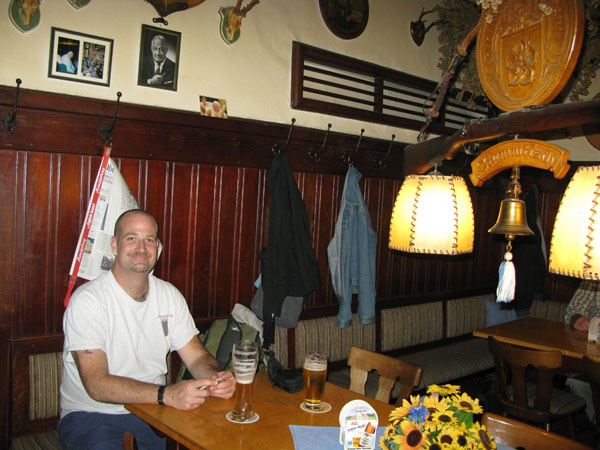 We had one more of the local beers to try, so I walked into Gasthof Flötzinger… Merideth was shopping next door and would join me momentarily.
We had one more of the local beers to try, so I walked into Gasthof Flötzinger… Merideth was shopping next door and would join me momentarily.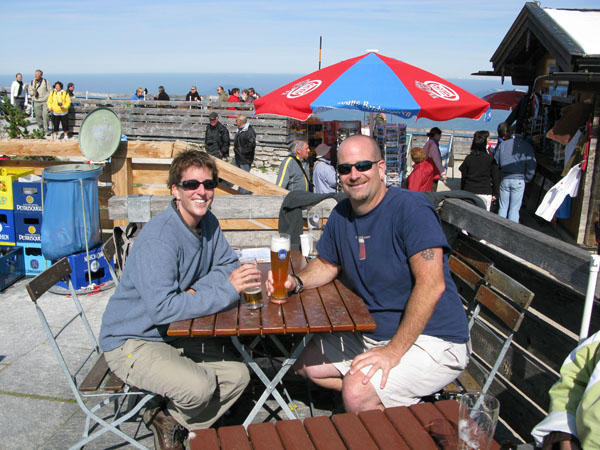 Chris and I have been subsisting on pork and beer for the last couple of days, which means we must be in our favorite place to travel: Germany. We are here for Oktoberfest, but needed a few days to acclimate and rest before heading to the Munich craziness. After landing in Frankfurt, we hopped on the autobahn and sped for Bavaria. Our stop on the first night was Murnau, south of Munich almost to the Austrian borderThere are two breweries in Murnau, including the Hotel Griesbrau, our lodging for the night.
Chris and I have been subsisting on pork and beer for the last couple of days, which means we must be in our favorite place to travel: Germany. We are here for Oktoberfest, but needed a few days to acclimate and rest before heading to the Munich craziness. After landing in Frankfurt, we hopped on the autobahn and sped for Bavaria. Our stop on the first night was Murnau, south of Munich almost to the Austrian borderThere are two breweries in Murnau, including the Hotel Griesbrau, our lodging for the night. The highlight of the evening was the large table that ordered a whole roast pig. Called the ‘Spanferkelspektakel’, the pig, complete with sparklers, is wheeled through the braustubel on a cart accompanied by the blaring sound of the James Bond theme. It looked delicious, but unfortunately the party of about 15 wasn’t sharing. I’m not quite sure why they used James Bond… maybe Rocky would have been better.
The highlight of the evening was the large table that ordered a whole roast pig. Called the ‘Spanferkelspektakel’, the pig, complete with sparklers, is wheeled through the braustubel on a cart accompanied by the blaring sound of the James Bond theme. It looked delicious, but unfortunately the party of about 15 wasn’t sharing. I’m not quite sure why they used James Bond… maybe Rocky would have been better.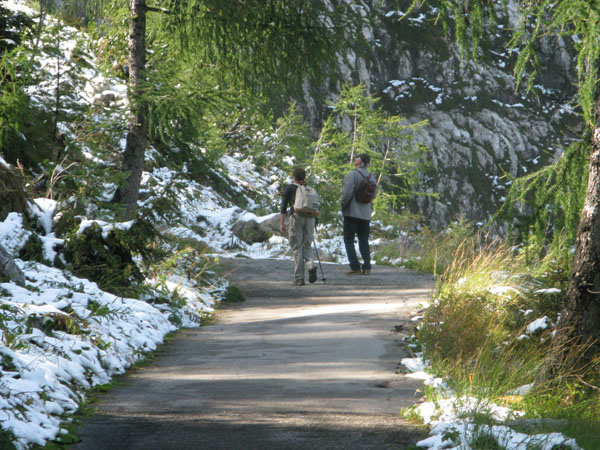 Thursday, Chris and I did something that we have been talking about since our last visit to Berchtesgaden, hike to the Eagles Nest. Since we arrived, the weather has been somewhat chilly-mid 50s- and we could see snow up on the mountain. There have also been clouds in the sky, which has obscured our view of the Eagle’s Nest from our hotel room.
Thursday, Chris and I did something that we have been talking about since our last visit to Berchtesgaden, hike to the Eagles Nest. Since we arrived, the weather has been somewhat chilly-mid 50s- and we could see snow up on the mountain. There have also been clouds in the sky, which has obscured our view of the Eagle’s Nest from our hotel room.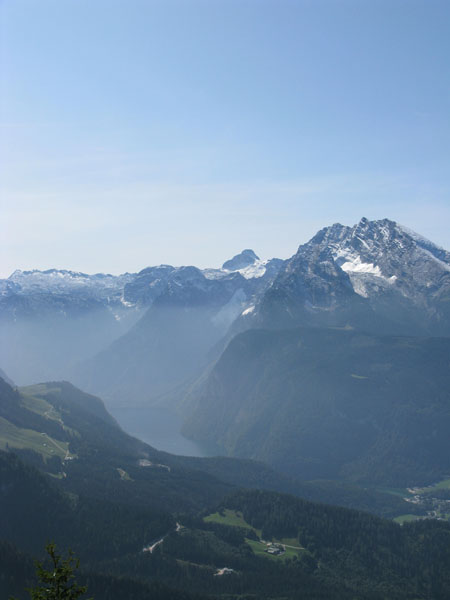 We survived the climb to witness the magnificent view. Even though Hitler spent very little time there, the fact that we were enjoying the beautiful view dedicated to such an evil man was not lost on us. However, everyone else simply enjoyed it, Germans and Americans alike. I guess that’s what I get for being married to a history major.
We survived the climb to witness the magnificent view. Even though Hitler spent very little time there, the fact that we were enjoying the beautiful view dedicated to such an evil man was not lost on us. However, everyone else simply enjoyed it, Germans and Americans alike. I guess that’s what I get for being married to a history major.